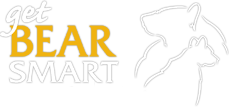Making parks safe for people and bears
Green spaces are an important part of designing a community that is attractive and liveable. Green spaces and parks encourage contact with the natural world, as well as non-motorized forms of exercise and transportation. Who could imagine living in a community without parks?
But community “green spaces” are also a potential source of human-bear conflicts because they are attractive to both bears (for food and security) and people (for recreation). Designating and managing them with this in mind is an important part of creating a Bear Smart community.
Green spaces can include vacant properties that are over-grown with vegetation, undeveloped areas adjacent to the community, parks, trail networks and alleyways, children’s playgrounds, school playing fields, golf courses, ski hills, hydro-transmission right-of-ways and small residual forest patches or landscaped strips left throughout developed zones. Reducing their attractiveness to bears or limiting human use of these areas at certain times of the year can reduce conflicts and keep everybody safe.
These natural areas are typically identified in the bear hazard assessment and included in the human-bear conflict management plan, along with recommendations on how to resolve their potential to cause conflicts. Steps designed to eliminate the potential for these non-natural features to contribute to a conflict situation in the community should also be addressed in the community’s conflict management plan.
For more information and recommended techniques, see section 6.5 in B.C.’s Bear Smart Community Program – Background Report.
Removing plants attractive to bears
It is important to remove plants (or their fruit) that are attractive to bears in areas where you don’t want bears to feed. These plants can include non-native ornamental shrubs and trees that produce berries/fruit as well as natural bear foods, such as buffalo-berry and huckleberry.
The main areas of concern should be heavy human-use areas, particularly adjacent to children’s play areas and the core area of the community. Give consideration to walkways and building entrances, as well as areas with busy vehicular traffic – nothing draws a bear close to a highway like a sprouting patch of clover.
Consider prohibiting the use of bear foods as ornamental shrubs or landscaping features. This will help prevent problems before they occur.
Watch a video on YouTube about removing berry producing plants, like mountain-ash, from landscaping. Watch Part II.
Brushing
In some communities, bears may use vegetation cover within and adjacent to the community for security cover while feeding on garbage and other non-natural attractants. As long as bears have access to non-natural foods, removing brush may reduce the likelihood that some bears will travel through the community, but it won’t solve the problem. The only real solution is to eliminate access to non-natural foods in your community.
Once non-natural foods are no longer available to bears, brushing can then be focused on achieving the following objectives:
- reduce the amount of natural bear foods in feeding areas that are commonly used by humans, and
- increase visibility where people are most likely to surprise bears, such as along trails and in areas frequented by user groups that may be at higher risk, such as schools, playgrounds, and campgrounds, particularly in those in areas that are on the outer edges of the community.
The risk of human-bear conflicts relative to the cost to other species and the priorities of the community should be evaluated when establishing plans to remove vegetation. Species other than bears (and people) also use green spaces, and their locations and behaviour should be documented and the potential impacts assessed before brushing occurs.
Measures to reduce the impacts to other species should be taken. In some cases there will be a trade off between the benefits of clearing or modifying green space to increase human safety versus the cost of eliminating natural bear or other wildlife habitats.
